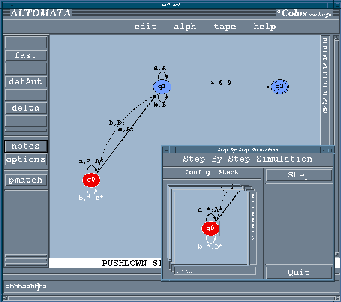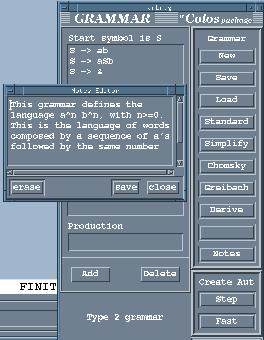The Formal Languages Environment AUTOMATA
Introduction
AUTOMATA is a tool for modelling automata and experimenting with grammars. The environment deals with:
- finite state automata - FSA, both deterministic and non deterministic
- push-down automata - PDA, both deterministic and non deterministic
- finite state transducers, Moore and Mealy machines
- grammars
- regular expressions
- pattern matching, a module to generate automata given a pattern matching problem
There is available a concise tutorial on automata theory and the AUTOMATA manual.
Contents
A finite state automaton is a mathematical model of systems which have a finite number of internal states and respond to external world just by changing their internal state. A finite state machine can be croach Automata theory is very rich and elegant. It is a mathematical subject that have several practical and useful applications but it is usually introduced very formally to students. Nevertheless scientists are often asked to design automata to describe systems.
It is therefore important to be able to practice and experiment with them and not only to deal with formal theorems. Moreover it is important to become familiar with different equivalent formalisms to deal with the same problem. The application allows to interactively design an automaton, to simulate it on an input and to learn about the equivalent grammar.

A PDA during back-tracking
Implementation
The application allows:
- to define an automaton, FSA or PDA, giving its state diagram and to simulate its computation step by step on a given input string
- to deal with non determinism and back-tracking
- to minimise a FSA
- to visualize the algorithm to transform a non deterministic FSA into a deterministic one
- to compute the regular expression of a FSA and viceversa
- to generate the FSA providing solution to a pattern matching problem
- to compute the grammar of the language accepted by an automaton
- to define and simulate finite state transducers, in particular the so called Moore and Mealy machines
- to define type-3 and type-2 grammars. The Grammar module provides several functionalities:
- simplification of the grammar
- computation of different equivalent forms
- derivation of productions and visualization of the derivation tree
- computation of the equivalent automaton, finite or push-down
- control of the membership of a given word to a language

The Grammar module: its look-and-feel